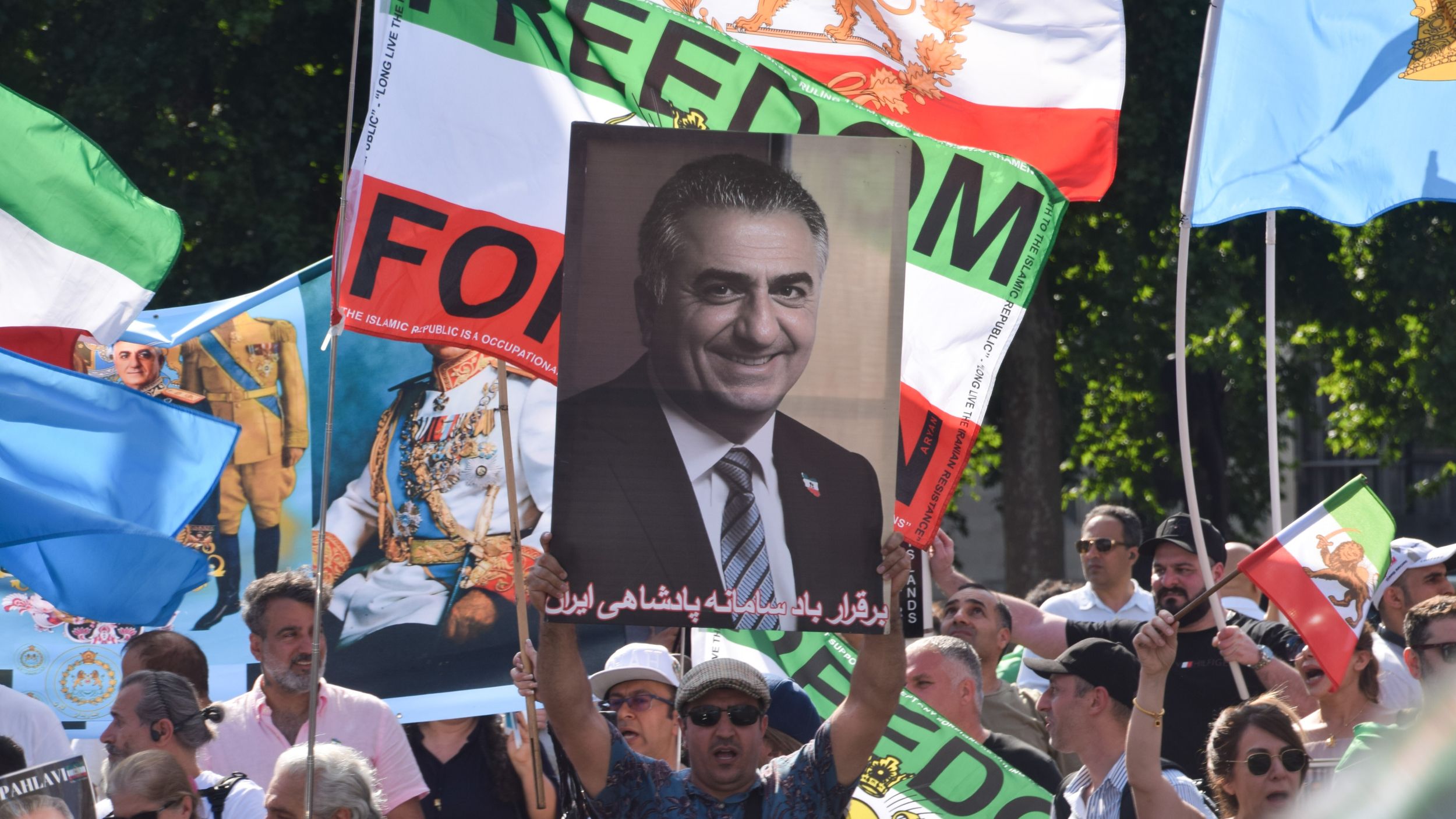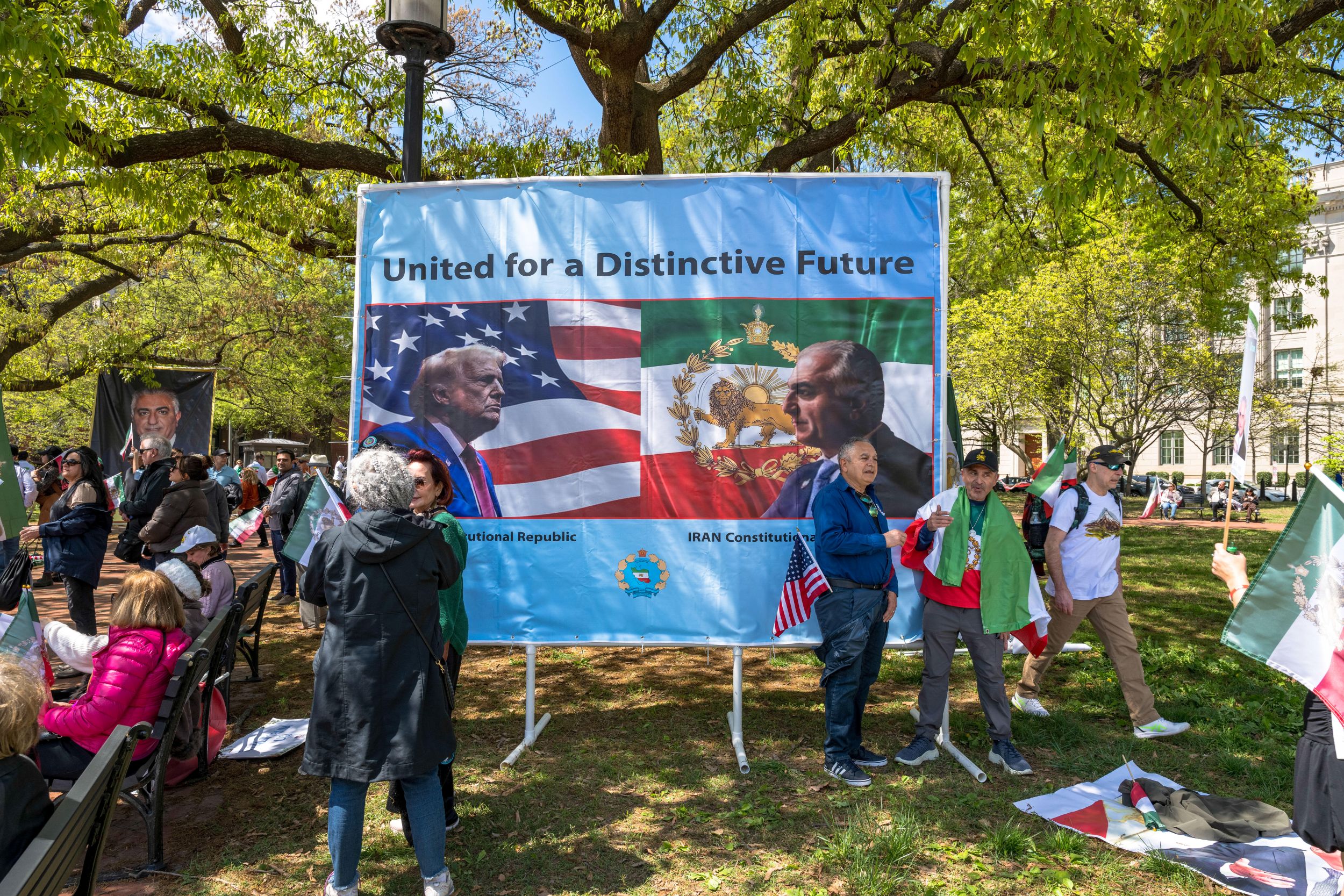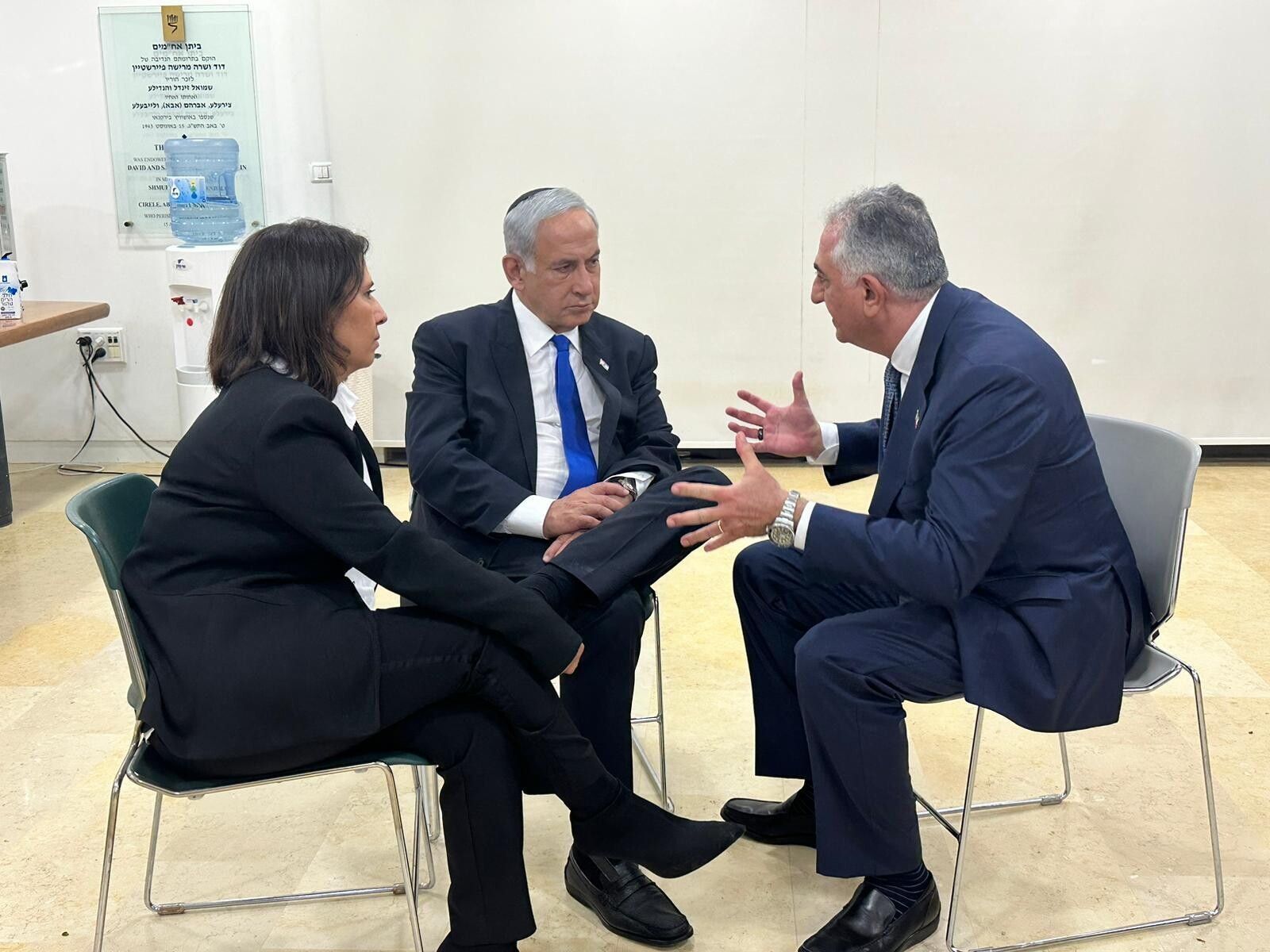Producing nostalgia, courting war

The 12-day war between Iran, Israel and the United States killed over a thousand Iranians, triggered the temporary exodus of hundreds of thousands of Tehran residents and spread fear throughout the country.
But a segment of the diaspora—particularly monarchists close to former Crown Prince Reza Pahlavi, eldest son of the last Shah—openly supported the conflict as a historic opportunity to overthrow the Islamic Republic. Pahlavi's wife, Yasmine, posted a picture on Instagram of graffiti reading: "Hit them, Israel, Iranians are behind you."
Based primarily in North America and Europe, monarchists have experienced a resurgence of influence in recent years, fuelled by the rise of satellite TV channels and social media. Through these platforms, they promote a nostalgic, royalist narrative, marginalise other democratic opposition movements and advance a pro-Israeli stance, supportive of war with Iran and opposed to any form of diplomacy.
By shaping narratives and perceptions, including increasingly within Iran's working classes, these channels have become powerful instruments in a broader psychological and informational war.
Monarchists have sought to redefine Iranian identity—hijacking the "Women, Life, Freedom" movement; promoting a model of leadership that sidelines dissenting voices within the opposition; and instrumentalising the war on Gaza through strategic alignment with Netanyahu, Trump, and the "maximum pressure" doctrine as a route to power.
Manoto: rewriting the past
Most Iranians today were not yet born during the reign of the Shah. Their understanding of history, beyond the state's official version, has been largely shaped by satellite channels, especially the monarchist-leaning Manoto and, to a lesser extent, Iran International. These channels have enabled a complete reinterpretation of recent Iranian history, reshaping collective memory by fostering a nostalgic, revisionist imagination and rehabilitating figures associated with the most repressive apparatuses of the former regime.
In Iran, television remains monopolised by the national group Sedā o Simā, but since the late 1990s, satellite dishes have proliferated on rooftops across cities and villages, circumventing state censorship. Today, a majority of Iranian households access these diaspora-led channels daily.
Manoto was launched in London in 2010. Initially focused on mainstream entertainment, it broadcasts films, series and variety shows. However, it is mostly through its documentaries that Manoto engages in Iran's memory war. Using archives obtained through their networks inside Iran, and extensive restoration and colourisation work, they have reintroduced forgotten or banned images to Iranian screens.
The channel imposes not only an idealised image of the monarchical past but also, through, for example, cooking and music shows, broadcasts alternative lifestyles and cultural norms to those of the regime. This includes an absence of visible religious codes, Westernised clothing, globalised consumption habits (music, travel, gastronomy, pop culture) and more liberal, individualised family models.
The Pahlavi monarchy is portrayed as an era of glory, progress and national pride. Expert discussions on air further support this narrative. The repressive apparatus of the time—the secret police (SAVAK), torture and executions of dissidents, the misery of slums while elites lived in luxury—are almost entirely erased from the story. The pinnacle of this rewriting came in 2024, when Manoto broadcast a seven-hour interview with former senior SAVAK official Parviz Sabeti, in which he publicly justified and glorified his terror policies, without challenge or criticism.
The channel distinguishes itself from state television and other satellite channels through innovative formats like "citizen journalism," broadcasting videos sent by Iranians inside the country that document institutional failures, poverty and daily repression. By doing so, it attracts a much broader audience, including working-class viewers, offering a critical mirror of their present while projecting an idealised image of the past.

Manoto's ability to reach both the middle and working class—a class whose parents largely supported the 1979 Islamic Revolution—has been a major factor in its success. This social bridge is a rare achievement for an Iranian opposition often hampered by fragmentation, lack of organisational coherence and an absence of solid media relay.
Now a powerful echo chamber for the monarchist movement, as of 2023, Manoto ranked as the ninth most-followed Persian-language page on social media, with over 17 million followers. It has become the second most-watched Persian-language TV channel, just behind BBC Persian—a longstanding pillar of British soft power.
Historically, monarchism was championed by elites who fled in 1979 and found resonance among the upper-middle classes in Iran. This base has been broadened by widespread satellite dishes, erosion of trust in institutions, weariness with official discourse and television's central role in domestic life.
In Iran, television is not just entertainment; it structures family interactions, paces evenings and often remains on permanently, making it a key channel of politicisation. Manoto has expanded beyond the wealthy northern Tehran neighbourhoods to gradually gain suburban, rural, and provincial areas, traditionally more conservative.
It broke away from the model of monarchist satellite channels of the 1990s and 2000s, which centred on a static presenter speaking directly to the camera—figures rooted in the post-1979 exile—with limited influence inside Iran. The new generation currently leading the channel is made up of professionals born and trained under the Islamic Republic, some of whom have worked for state television. They have mastered contemporary social, cultural and linguistic codes and produce content much more rooted in the country's reality, far from the frozen memories of decades-old exile.
Making Iran great again
The battle on social media also deserves particular attention. Through the widespread circulation of viral monarchist content—Instagram reels, TikToks, memes and archival footage—set to epic, patriotic, or pre-revolutionary pop soundtracks, monarchy supporters seek to reconstruct an Iranian identity rooted in Persianness and the legacy of the Pahlavi monarchy, cast as an era of modernity, freedom and prosperity.
Through the revival of monarchist iconography and storytelling, an idealised vision is constructed to legitimise the reestablishment of a political order grounded in visions of grandeur and an ostensibly timeless heritage.
This visual and discursive phenomenon takes place in a context of dispersed political mobilisation. A fragmented diaspora grappling with questions of identity and struggling to rebuild collective ties, and a domestic population deprived of public space by relentless state repression, are exposed to dangerously simplistic yet persuasive messages. These online narratives, infused with far-right elements, promote a nostalgic slogan: "Things were better before; let's make Iran great again."
The online monarchist camp stands out for its internal diversity: nostalgic young influencers, radical pan-Iranist groups, constitutional monarchists, royalist Kurds—each with a slightly different discourse tailored to their niche. In contrast, other anti-regime factions—exiled reformists, liberals, nationalist-religious figures, leftists, and parties representing ethnic minorities—struggle to offer a coherent ideological backbone, unifying slogan or media output of comparable scope.

Videos produced by certain monarchist influencers, artists and activists often combine passionate yet aggressive language. These messages empathise with the audience’s pain before designating a scapegoat: the Islamic Republic, the religious population of Iran, leftists or other opposition factions, including those who support a diplomatic solution.
Algorithms play a central role in this dynamic. Interconnected and mutually reinforcing, they circulate monarchist content across platforms and feed echo chambers. By amplifying the reach of polarising and visually striking content, social media platforms contribute to the diffusion and normalisation of radical discourse. This phenomenon is fueling the rise of an increasingly hardline monarchism, especially among younger and less politicised audiences.
"Woman, Life, Freedom"
Monarchist circles found an unprecedented springboard in the "Woman, Life, Freedom" uprising, sparked in September 2022 by the death of Jina Amini, a young Kurdish woman killed by the morality police. The movement builds on Kurdish leftist feminist struggles, adopting the slogan "Jin, Jîyan, Azadî" from the PKK and Komala movements.
The protests quickly spread across Iran, uniting urban youth, wealthy and middle-class citizens, impoverished populations, marginalised minorities and rebellious suburban communities. Gradually, monarchist networks sought to impose their leadership over the movement, despite having no organic link to the early popular revolts and attracting little sympathy in peripheral regions. In a context of partial internet shutdowns and social media censorship imposed by Iranian authorities, satellite channels like Manoto and Iran International became the main interfaces between inside and outside the country. Information leaves Iran, is reworked, filtered, and amplified by the diaspora before returning as images, narratives, and directives.
In January 2023, activist Hamed Esmaeilion and journalist Masih Alinejad joined a group of about twenty Iranian activists and intellectuals to draft a manifesto for Iran's future. One early debate was whether to include Reza Pahlavi—not as a leader, but as an equal participant. This collective soon split, and in March, Esmaeilion and Alinejad turned towards a new, more publicised coalition: the Alliance for Democracy and Freedom, which was supported by Georgetown University in Washington and amplified by the visibility of figures such as Reza Pahlavi and Golshifteh Farahani.
The resulting "Mahsa Charter" aimed to build a broad consensus on issues like democracy, human rights, justice, the economy and diversity. But critics from the left denounced the text as superficial and aligned with Western institutional logics. Kurdish parties criticised the centralised vision, while nationalists condemned the recognition of minority rights and the absence of explicit reference to the "Iranian nation"—nationalist discourses echoed by Manoto.
Pahlavi's push to bring more monarchists into the coalition sparked further tension. Some members reported online harassment from monarchist supporters. By April, the alliance had collapsed.
The episode illustrates both the chronic inability of the Iranian opposition in exile to build a lasting union, as well as the decisive weight of media infrastructure in the rise and fall of political initiatives. It also embodies the process of the "Woman, Life, Freedom" movement's confiscation by a diasporic elite whose interests, priorities and cultural codes do not always align with those of the majority of protesters inside Iran.
During the uprising, it was Iran's most marginalised groups who paid the highest price: almost half of those who died came from the Kurdish and Baloch minorities. Prisoners targeted for execution were largely from working-class milieus. This representational fracture is reproduced internationally, where journalists, politicians and NGOs often relay diaspora narratives without questioning their blind spots. The danger is twofold: part of the uprising is rendered invisible, while the most publicised figures impose a biased vision often modelled on Western references, by focusing, for example, on the veil.
In the background emerges a neocolonial dynamic, where the West delegates to a sometimes disconnected or discredited exile elite the production of regime-change narratives. A striking example is the 2022 invitation of Nour Pahlavi, daughter of Reza, to the French Senate. She has never lived in Iran, does not speak Persian fluently, and holds only the symbolic capital of her family name.
These gestures have a self-fulfilling effect: they publicly legitimise the monarchist claim to embody opposition, strengthening their status in the eyes of the diaspora and, by extension, among some Iranians inside the country.
Yet, many of the slogans chanted on Iran's streets clearly oppose the monarchy, such as the famous "Death to the oppressor, whether Shah or Supreme Leader!" Slogans like these were not broadcast on satellite channels, which preferred more palatable or monarchist ones, distorting the movement's reality.
Erasing Palestine
In April 2023, Pahlavi made a highly symbolic trip to Israel, meeting Netanyahu, President Isaac Herzog and Intelligence Minister Gila Gamliel. Just months before the outbreak of the Gaza war, the aim of the visit was to strategically align with the Israeli-American far right and bolster Pahlavi's media legitimacy while the democratic alternative in Iran collapsed.

In Israel, Pahlavi leveraged "Woman, Life, Freedom" symbols, twisting a cry against state violence in Iran to legitimise state violence elsewhere. In Netanya, he visited a mural depicting a bird covering a woman's eye, referencing the deliberate targeting of protesters' eyes by Iranian security forces. Ironically, this blinding tactic has also been widely used by the Israeli army against Palestinians, without appearing to trouble Pahlavi. His wife, Yasmine, posted photos of female Israeli soldiers alongside the slogan "Woman, Life, Freedom."
Pahlavi's unconditional support for Israel dates back to 1982 when Israeli intelligence attempted to reinstall him via a coup. Since then, he has appeared frequently in neoconservative American media, attended congresses such as the Israeli American Council, mingled with figures like S. Adelson—a Republican billionaire who proposed "nuking Iran"—and relentlessly echoed Netanyahu's hardline stance. He is a regular at the Washington Institute for Near East Policy, a think tank linked to AIPAC, the main pro-Israel lobby in the US. He later supported Trump's second term and the "maximum pressure" strategy on Iran, claiming harsh economic sanctions are "what Iranians want."
As Gaza became a theatre of massacre, his supporters demonstrated alongside pro-Israeli far-right groups, brandishing Pahlavi portraits and monarchist flags. Lobby groups such as the National Union for Democracy in Iran emerged, targeting Iranian-Americans critical of Israel. Pahlavi thus seeks to instrumentalise the conflict and Iranian popular frustration to hasten the Islamic Republic's fall, choosing silence in the face of Israeli state violence and even offering it support and legitimacy. For an opposition figure claiming to represent an ethical break with the current Iranian regime, he has failed to draw even the most minimal ethical line.
In this climate of psychological warfare, Manoto and Iran International reinforce the narrative of "maximum pressure" and foreign intervention. They have become powerful platforms for anti-Palestinian rhetoric, instilling in many Iranians that Gaza and Lebanon have "stolen" Iran's wealth via Iranian support for Hezbollah and Hamas— justifying the total abandonment of the Palestinian cause and promoting Pahlavi as a providential figure.
Unlike Manoto, Iran International does not openly identify as monarchist, though it has shown clear sympathies for that current, also visible in its strong alignment with pro-Israeli narratives. During the 12-day war, the channel's star presenter, Pouria Zeraati, interviewed Benjamin Netanyahu in a segment that resembled a propaganda platform more than a journalistic exchange.
Iran International has consistently amplified the Israeli state's point of view, becoming the first Persian-language outlet to produce an exclusive report from inside an Iron Dome base. In that segment, the journalist interviewed the Israeli commander, while failing to include any perspectives from victims of the occupation in the West Bank or Gaza.
Another particularly surreal video circulated on social media that encapsulated the station's stance: an Iranian journalist writing the revolutionary slogan "Woman, Life, Freedom" on the ruins of a Palestinian home in Gaza.
The turban or the crown?
Aligned with Trump and Netanyahu, Iran's monarchists have joined the new international far right, sidelining the Palestinian question and supporting military confrontation with the Islamic Republic while seeking to shape a new, homogenised Iranian identity around Persian nationalism and the legacy of the Pahlavi dynasty. Paradoxically, they have come to resemble the regime's ultra-conservatives, sharing their opposition to pro-democracy forces, militarism, xenophobia against Afghans and marginalisation of minorities.
The monarchist stance contrasts with that of many committed figures for democracy and social justice inside Iran, who are often targeted by monarchists and imprisoned by the regime. This group includes Nobel Peace Prize laureate Narges Mohammadi, lawyer Nasrin Sotoudeh, Kurdish feminist activist Pakhshan Azizi and trade unionist Reza Shahabi.
These activists have consistently emphasised that the slogan "Woman, Life, Freedom" calls for the defence of human dignity and the fight against all forms of discrimination, state violence, and religious fundamentalism—whether in Iran or Israel. These actors, bearing democratic ideals and equipped with technical and organisational skills, could ensure effective governance if regime change occurs.
Yet their social base remains limited, not only due to the repression carried out by the Iranian state, but also because of the dominance of monarchist currents within the exiled opposition. This monarchist hegemony, reinforced by unequal access to media resources, creates a deep asymmetry in the distribution of power and voice within the contemporary Iranian political sphere.
In the days following the war, true to its totalitarian machinery, the Islamic Republic resumed repression: mass imprisonments and executions of opponents justified by espionage accusations for Israel and in the name of state security. Ultimately, Iran deserves much more than a choice between the turban and the crown: it deserves genuine democratisation.
© Qantara